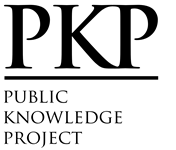Variation of nitrate concentration and light level on growth rate of diatom Chaetoceros muelleri
Abstract
Microalgae are cultured as natural feed for the cultivation of mollusks, crustaceans (early larval stages), and zooplankton. Diatoms are phytoplankton groups commonly used as feed, one of which is Chaetoceros muelleri. This study aims to identify the optimal nitrate concentrations and light level (irradiance) for the growth rate of C. muelleri. Culture was placed in nitrate 1,330; 5,305; and 27,030 mg/L (N1, N2, N3, respectively); and light 50, 100, and 150 µmol/m2/s, with three replications for each treatment. The response variable observed was the growth rate of C. muelleri and nitrate uptake. Each nitrate treatment resulted in a significant difference in the growth rate of C. muelleri (LSD, p < 0.01). The N3 treatment produced the highest growth rate (average 0,188-0,193 cells/day), while N1 produced the lowest specific growth rate (average 0,149-0,157 /day). In light treatment, a significant difference was only seen in the light level
of 150 µmol/m2/s (LSD, p < 0.05) which produced the highest growth rate (average 0.157-0.193 cells/day), especially in the nitrate N1 and N2. Meanwhile based on the significance test, the interaction between nitrate and light treatment was not significant.
Keywords: Chaetoceros muelleri; Growth rate; Irradiance; Nitrate
Full Text:
PDFReferences
Admiraal, W. 1977. Tolerance of estuarine benthic diatoms to high concentrations of ammonia, nitrite ion, nitrate ion, and orthophosphate. Marine Biology. 43:307-315.
Andersen, R. A., Berges, J. A., Harrison, P. J., Watanabe, M. M. 2005. Appendix A-recipes for freshwater and seawater media. Di dalam: Andersen RA, editor. Algal Culturing Techniques. Burlington (US): Elsevier Academic Press. 429-538 pp.
Ashokkumar, S., Manimaran, K., Kim, K. 2015. Cultivation and Identification of Microalgae (Diatom). In S.-K. Kim and K. Chojnacka (eds). Marine Algae Extracts. DOI: https://doi.org/10.1002/9783527679577.ch4.
Bates, S. S., Worms, J., Smith, J. C. 1993. Effects of ammonium and nitrate on growth and domoic acid production by Nitzschia pungens in batch culture. Can. J. Fish. Aquat. Sci. 50:1248-54.
Batista, I. R., Garcia, A. B., Dalen, P. V. Kamermans, P., Verdegem, M., Smaal, A. C. 2015. Culturing Chaetoceros muelleri using simplified media with different N sources: effects on production and lipid content. Eur. J. Phycol., 50: 9299. DOI: 10.1080/09670262.2014.994137.
Creswell, L. 2010. Phytoplankton culture for aquaculture feed. Southern Regional Aquaculture Center Publication No. 5004. September 2010.
Davidovich, N. A., Davidovich, O. I., Podunai, Y. A., Shorenko, K. I., Kulikovskii, M. S. 2015. Reproductive properties of diatoms significant for their cultivation and biotechnology. Russian Journal of Plant Physiology. 62(2): 153-160.
Dixit, S. S., Smol, J. P., Kingston, J. C., Charles, D. F. 1992. Diatoms: powerful indicators of environmental change. Environ. Sci. Technol. 26(1): 23-33.
Du, Y., Hsu, S. B., Lou, Y. 2014. Multiple steady-states in phytoplankton population induced by photoinhibition. J. Differential Equations. 258:2408-2434. DOI: http://dx.doi.org/10.1016/j.jde.2014.12.012.
Duerksen, S. W., Thlemann, G. W., Budge, S. M., Poulin, M., Niemi, A., Michel, C. 2014. Large, omega-3 rich, pelagic diatoms under Arctic Sea ice: sources and implications for food webs. PLoS ONE. 9(12): 1-18. DOI: 10.1371/journal.pone.0114070.
Eppley, R. W., Thomas, W. H. 1969. Comparison of half-saturation constants for growth and nitrate uptake of marine phytoplankton. J. Phycol. 5:375-379.
Glover, T., Mitchell, K. 2016. An Introduction to Biostatistic Third Edition. Illinois (US): Waveland Press, Inc.
Gotelli, N. J. 2001. A Primer of Ecology Third Edition. Massachusetts (US): Sinauer Associates, Inc.
Guillard, R. R. L., Sieracki, M.S. 2005. Counting cells in cultures with the light microscope. Di dalam: Andersen RA, editor. Algal Culturing Techniques. Burlington (US): Elsevier Academic Press. p 239-252.
Helm, M. M., Bourne, N., Lovatelli, A. 2004. Hatchery Culture of Bivalves – A Practical Manual (FAO Fisheries Technical Paper 471). Food and Agriculture Organization of the United Nations, Rome.
Kumaran, J., Jose, B., Joseph, V., Singh, I. S. B. 2016. Optimization of growth requirements of marine diatom Chaetoceros muelleri using Response Surface Methodology. Aquaculture Research. 1-12. DOI: 10.1111/are.12987.
Langhans, R. W, Tibbitts, T. W. 1997. Plant Growth Chamber Handbook. Iowa (US): Agriculture Information Services, Iowa State University.
Noerdjito, D. R. 2017. Perkembangan, produksi, dan peran kultur mikroalga laut dalam industri. Oseana. 42(1):18-27. DOI: doi.org/10.14203/oseana.2017.Vol.42No.1.35.
Nybakken, J. W., Bertness, M. D. 2005. Marine Biology: an Ecological Approach 6 th Edition. San Fracisco (US): Pearson Benjamin Cummings.
Pal, S. W., Singh, N. K., Azam, K. 2013. Evaluation of Relationship between light intensity (lux) and growth of Chaetoceros muelleri. Oceanography. 1(3):1-4. DOI: http://dx.doi.org/10.4172/2332-2632.1000111.
Reynolds, C. S. 2006. The Ecology of Phytoplankton. Cambridge (UK): Cambridge University Press.
Serôdio, J., Lavaud, J. 2020. Diatoms and their ecological importance. In: Leal Filho, W., Azul, A.M., Brandli, L., Lange Salvia, A., Wall, T. (eds) Life Below Water. Encyclopedia of the UN Sustainable Development Goals. Springer, Cham. DOI: https://doi.org/10.1007/978-3319-71064-8_12-1
Schmidt, G. 1983. Note on the effect of high nitrate concentration and light intensity in the growth and uptake rates of Phaeodactylum tricornutum (Bohlin) culture. Bolm Inst. Oceanogr. S Paulo. 32(1):91-98.
Tantanasarit, C., Englande, A. J., Babel, S. 2013. Nitrogen, phosphorus and silicon uptake kinetics by marine diatom Chaetoceros calcitrans under high nutrient concentrations. Journal of Experimental Marine Biology and Ecology. 446: 67-75. DOI: http://dx.doi.org/10.1016/j.jembe.2013.05.004.
Velasco, L. A., Carrera, S., Barros, J. 2016. Isolation, culture and evaluation of Chaetoceros muelleri from the Caribbean as food for the native scallops, Argopecten nucleus and Nodipecten nodosus. Lat. Am. J. Aquat. Res., 44(3): 557568. DOI: 10.3856/vol44-issue3-fulltext-14.
Wada, E., Hattori, A. 1978. Nitrogen isotope effects in the assimilation of inorganic nitrogenous compounds by marine diatoms. Geomicrobiology Journal. 1(1):85-101.
Yi, Z., Xu, M., Di, X., Brynjolfsson, S., Fu, W. 2017 Exploring valuable lipids in diatoms. Front. Mar. Sci. 4(17):1-10. doi: 10.3389/fmars.2017.00017
DOI: https://doi.org/10.29103/aa.v9i2.6789
 Article Metrics
Article Metrics
 Abstract Views : 481 times
Abstract Views : 481 times
Refbacks
- There are currently no refbacks.
Copyright (c) Acta Aquatica: Aquatic Sciences Journal

This work is licensed under a Creative Commons Attribution 4.0 International License.









